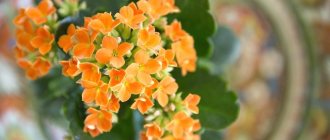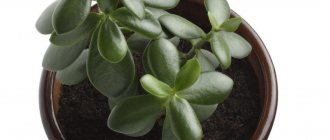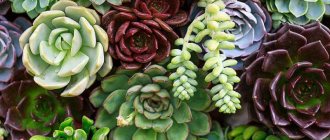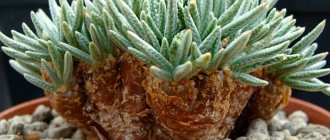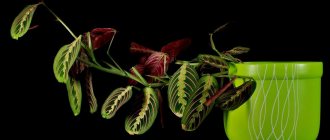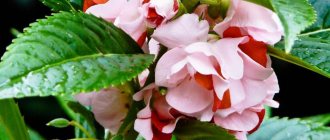The majestic begonia (one of the varieties was not called royal for nothing) is a unique flower. One of the few tropical plants, the species of which combine several different classes, begonia can climb like a vine, grow as a bush or a small leafy cap, and delight the eye with a variety of colors of buds or foliage. All this is begonia. Care at home - the photos speak for themselves: the flower is incredibly beautiful.
Begonia bush.
Begonia creeper.
Begonia blooming.
Begonia leaves.
Together with the portal agronom.guru, we will learn more about this exotic guest, talk about caring for the plant, the characteristics of begonia propagation, analyze the difficulties that can arise with improper care, and study the varieties of the flower with photos and names. The homeland of begonia is the hot tropics, or rather the Antilles. The plant was first found and described by the French biologist Charles Plumier in 1687. However, the exotic flower received its name thanks to the “sponsor” of the expedition, Michel Begon.
The Antilles - the birthplace of begonia
The main feature is abundant flowering all year round. Begonias “fall asleep” for a short time. And young plants with still unripe tubers can generally “boycott” the regime of winter sleep and rest.
Begonia is very popular among breeders. So much so that there are twice as many hybrid forms as decorative varieties. Of the three thousand known flower variations, two are hybrids.
They thrive in damp, shady places – in rock crevices and tree roots. Distributed in the subtropics of America, Southeast Asia and Madagascar and Hawaii.
Begonia in Hawaii.
There are types of flowers that are not afraid even of salt water. In the Philippines, begonias do well on limestone cliffs. In the Andes and Himalayas they can grow high above sea level. There are also succulent forms that absorb water into the tubers. There are artificially grown ones, for example, this begonia is shaped like a Japanese bonsai tree.
Begonia Bonsai Schmidt.
Begonia - brief botanical information
By type, begonias can be divided into annual and perennial. Plants are so diverse that it is impossible to describe all its characteristics. However, there are some features common to all begonias:
- leaf asymmetry;
Royal begonia leaf.
- bright flowers : white, yellow, red, pink, edging possible;
In terms of beauty and richness of its buds, begonia can compete even with the queen of flowers - the rose.
- the fruits , if not removed, have the shape of a box. In nature, this is how a plant reproduces - the film bursts and the seeds are carried away by the wind.
The seeds of some types of begonia are extremely small - there can be up to 75 thousand of them in one gram.
There are many types of begonia. There are evergreen varieties, there are deciduous, perennial and annual, outdoor and indoor, creeping and tall. In floriculture, the following classification is usually used: decorative deciduous and flowering. Types of indoor begonias, photos with names, let's look at them right now.
Tuberous: features, characteristics
This variant of representatives of the world of flora assumes the presence of a perennial tuber that constantly grows and stores nutrients.
Tuberous begonia has chic decorative properties; it can bloom continuously for 5-6 months , which makes it in demand when decorating the designs of residential and non-residential interiors.
Many florist experts claim that begonia is not inferior in beauty to such popular flowering plants as roses and dahlias. The most in demand are hybrid varieties with large double flowers and a bright border around the edges.
Types of decorative foliage plants: names and photos
This group contains those representatives of the large begonia family that are distinguished by unusual foliage. Decorative deciduous begonias, look at the photos and names.
Royal
Begonia Royal.
The homeland of this variety of begonia is India and Asia. Leaves of unusual shape and bright color. The veins of the leaves are usually lighter, the flesh is darker. The photo shows a variety of royal begonia - Rex.
Begonia rex.
In Russia, the flower discovered by the Frenchman was jokingly called “Napoleon’s Ear,” comparing it with the ears of the commander who shamefully fled from snow-covered Russia in 1812. Royal begonia (photos of varieties) in home care is a capricious plant, afraid of drafts.
Varieties of Royal Begonia.
The flowers here are more modest. High humidity is required. Caring for Rex begonia at home: the rhizome of the plant spreads along the top layer of soil, so a shallow but wide pot is suitable for the flower.
Tiger
Unlike its predecessor, tiger begonia is an artificially bred plant. This unusual indoor begonia flower, as in the photo, will become a decoration and natural ionizer for any apartment.
Tiger begonia.
The leaves have a specific color, from a distance reminiscent of a tiger, with white fluff on the edges. Quite a compact flower. Tiger begonia at home requires some care; the photo shows a rare flowering of tiger begonia.
Tiger begonia blooming.
In order to ensure bright and deep color of the leaves, it is necessary to remove the flowers from begonias of this type. Then all the strength of the plant will go into the growth of leaves. The same is done with old leaves.
Cleopatra
Belongs to the type of bush begonias. The flower is long-lived; with proper care, the age of the plant can reach 4-5 years.
Begonia Cleopatra.
To increase the lifespan of begonias, “rejuvenation” is necessary - annual division of the bush. This is usually done in the spring, when the plant is replanted or cuttings.
Cleopatra is a miniature flower of an interesting color. The leaves are fluffy with light fluff, resembling frost from a distance.
Coral
This type of begonia is one of the hardiest plants. It has strong leaves and a thick, bamboo-like stem. This begonia is loved because it is tolerant of drying out, precisely because of its “margin of safety.” Here the flowers look like bunches of barberries.
Coral begonia.
The flower grows up to one meter in height and has paired leaves. It grows very quickly, as in the photo. If you provide coral begonia with proper care at home and a favorable climate, it can form a beautiful, voluminous bush up to half a meter wide. It is very important to choose the right container for the plant. It should be spacious enough to accommodate a massive rhizome; it is better to choose a clay pot. Such “dishes” heat up evenly and provide the plant with the desired temperature.
Metal
Metallic begonia.
The metallic begonia plant (photo above) received its name due to the specific grayish tint of the leaves. The stems of the plant branch well and have a dense structure. It grows more than a meter.
Begonia hogweed
Hogweed begonia.
Reminds me of hogweed leaves. Beautiful, dense pink stem, massive leaves with veins. An unpretentious plant with an extensive crown.
Begonia cuff
Cuff begonia.
The leaves are collar-shaped - pointed and elongated. The stem is quite fleshy with red fibers. Grows up to one meter. There is a darker variation of the plant - the black prince. Its leaves look like velvet.
Cuff begonia "Black Prince".
Watering and spraying
Begonia is watered with warm and well-settled water, and in winter - a couple of degrees warmer than the air in the room. This is a moisture-loving plant, so it is important that the soil does not dry out. If this does happen, leave the pot in a bowl of water for half an hour so that it covers about 2/3 of it.
Begonia loves humidity, so you can place the pots in trays with moistened sand or expanded clay. In summer you can spray the leaves, but this method is only suitable for varieties with non-hairy plates. In other cases, it is better to humidify the air around.
Dracaena: home care, propagation and transplantation
Types of decoratively flowering indoor begonia: names and photos
These plants are an excellent choice for a home flower garden. Ever-blooming begonia is easy to care for at home. Photos of plant varieties.
Begonia everblooming
Begonia Semperflorence.
Ever-blooming garden begonia.
Begonia ever-blooming terry.
Such begonias do not stop flowering almost all year round. The leaves are usually dense, small, oval in shape. In order for the plant to withstand the pressure of the buds, small wooden sticks are usually inserted into the soil, as in the photo.
Supportive procedures for ever-flowering begonia.
Caring for evergreen begonia at home involves periodic rejuvenation and replanting by cuttings.
Ampelnaya
This type of begonia is often used in landscape design. She looks great in a flowerpot.
Ampelous begonia in a flowerpot.
Ampelous begonia is used to decorate steps and stairs, as well as gazebos. The plant has curly flowers that create a voluminous and branched structure for the entire plant. The flower belongs to the category of tuberous flowers; in the photo there is a hanging begonia before planting.
Tuber of ampelous begonia.
The best time to plant a new plant is from February to April. It is during this period that daylight hours are optimal for tuber germination, and the sun's rays are not scorching.
Rules for planting hanging begonias: step-by-step instructions with photos
Let's take a tuber we already know. They are sold at any flower shop. When you buy a flower, pay attention to its density and elasticity. You cannot take hard tubers, they have lost the necessary moisture and will not germinate! On the way from the store, do not freeze the planting material.
| Photo | Actions |
| We pickle our tuber with special preparations - Maxim summer resident, Vitoros, Fitosporin. Dissolve according to the norm. The drug has a caustic, poisonous color so that you will never confuse it with any other liquid. You can hold it for 20 minutes. This will prevent our plant from fungal parasites that may have appeared during transportation. | |
| It is necessary to plant with the concave part up. These tubercles are the remnants of the previous stem; it is from here that the first buds will come, and then the sprouts. | |
| We prepare the containers. Our soil is disinfected with gleokladin. You can add trichoderma mushroom. The soil is quite wet. We remove some of the soil from the pots. | |
| In the sun, begonia dries out very quickly, so in order not to water it every day, we add hydrogel. This hydrogel should fill the container by about 1/3. This viscous substance absorbs excess moisture, and then portions it out to the flower, thereby ensuring such passive watering. Once the hydrogel is laid, you can water it. | |
| We fill in the remaining soil, but not completely. Because when stems form from these tubers, they will rise, and soil will need to be added to them. | |
| We deepen it just a little bit so that these “shoulders” of tubers remain on the surface. There is no need to do anything else, since our kidney was moistened with geoclodine in advance, plus we added hydrolell. The plant needs to “breathe” in the open air | |
| This is what our sprouts look like after a month. When they first appear, it is better to sprinkle them with vermiculite. This material is similar to sand. It prevents rot from developing near the root collar and helps to avoid its overmoistening. |
Ampelous begonia - features of care at home in winter
In winter, ampelous begonia does not bloom. However, due to the lush green “tent”, it looks quite good. It is important not to overwater the plant during this period. In addition, it is necessary to ensure sufficient lighting. If daylight hours are short, it is better to consider additional lighting. In winter, the main danger for begonias is drafts and temperature changes! From February, grown leaves need to be trimmed.
Elatior
The flower is a hybrid, the result of a “close friendship” between tuberous and Socotrans begonias.
Features of caring for begonia Elatior at home
Almost a greenhouse plant. Afraid of temperatures below 20°C and drafts. The shoots are quite fragile, so, as we have already shown, it is better to support the flower with a high pot or sticks.
Begonia Elatior.
Begonia Elatior Rebecca.
Two-color inflorescences of different shades delight lovers of fragrant beauty until late autumn.
IT IS IMPORTANT TO KNOW!
Periodically cutting off flowers will help stimulate active flowering.
For active flowering, the plant needs rich daylight, but it should not be placed in direct sunlight. This may burn the leaves. However, too much shading may result in the flower not blooming at all.
Fimbriata
Sometimes it is called velvet, it looks like a terry towel. The flowers are quite lush. Needle-shaped, a little like carnation flowers. A particularly favorite variety is Fimbriata yellow.
Begonia fimbriata.
Velvet begonia. Such plants are not inferior in beauty to chrysanthemums and roses. Begonia Fimbriata yellow is easy to care for and can be planted in open ground.
Picoti
It features an interesting two-tone color. The process of active flowering of each bud can reach three to four weeks. Flowering usually begins in late spring. It belongs to the type of tuberous begonias; the photo shows how unusual the color of this flower is.
Tuberous begonia Pikoti.
The rest period for this begonia begins with the arrival of autumn. It is better to pick even ripe buds at this time in order to leave strength to the leaves.
Catalog of indoor flowers with photos and their names. In a special publication on our portal we will talk in detail about indoor flowers. You will learn about types of indoor flowers, about fruit indoor flowers and get acquainted with a detailed photo gallery.
Ampel for home and office decoration
For home decor, small species of hanging begonia are used. They are planted in flowerpots or other hanging flowerpots so that the soft hanging stems with elegant tassels rise above the head and receive maximum light directly from above.
These representatives of the flora world bloom profusely. The root system is usually represented by a tuber , which increases in size throughout its life.
How to care for begonia at home
First of all, you need to take care of where the plant will be planted. The best option is a ceramic pot with a drainage system.
The best container for begonias is a ceramic pot.
This container will allow the plant to breathe and retain heat well.
REMEMBER!
The pot must be chosen so that, taking into account the root system, the plant is covered by another 4 cm of soil. A pot that is too spacious can lead to stagnation of excess moisture and rotting of the roots.
Soil selection
It is better to choose slightly acidic soil with a small amount of peat for begonias. A universal primer will also work. However, it needs to be given additional looseness. For this you can use vermiculite, perlite or coconut fiber.
IT IS IMPORTANT TO KNOW!
Before transplanting, the soil must be disinfected. This can be done in the oven at a temperature not exceeding 60°C.
Soil preparation.
Option for soil composition for begonias: equal parts sand, peat and rotted mullein. Or part of leaf soil, the same amount of coniferous soil and the same amount of sand.
Temperature and humidity
The ideal temperature for begonias is from +21 to -28°C. If the temperature problem is more or less solvable, but with humidity it’s more and more complicated. The easiest option is to use humidifiers. The most plausible (you can’t put a humidifier on every window) are pallets with expanded clay.
Plant moisturizing option.
Expanded clay must be constantly moistened.
But begonia leaves don’t like moisture! Do not spray them with water under any circumstances!
The water from the expanded clay will evaporate, and the humidity around the flower will increase.
Optimal lighting
The plant loves light, especially its flowering species. But the difficulty lies in the fact that when exposed to direct sunlight, the delicate leaves of begonias can get severe burns. The plant feels best on the eastern and western sides of the premises. If it is not possible to rearrange the plant, then shade the windows or cover them with film or paper.
Watering and fertilizing
The plant loves water. However, it must be remembered that excess moisture is detrimental to the root system. It is necessary to water only when the soil has dried out at least one and a half to two centimeters. And this depends on the conditions of detention and the season. In winter, watering is reduced, and tuberous species are cut off and placed in peat.
Begonia on the windowsill.
It is important to take into account the weather and humidity. If you plan to leave, hydrogel will help a lot. We talked about how to use it earlier. The bottom line is this: it retains moisture and gradually, as the soil dries, releases it. If there is no hydrogel, drainage can be used.
During flowering periods, fertilizing can be carried out at least every day; to do this, dilute the fertilizing solution in the watering container twice as weakly as usual. Then feeding the plant will not seem stressful to it. Any mineral fertilizers are suitable for these purposes. There are special ones for different types of begonias.
For flowering types of begonias, nitrogenous fertilizers cannot be used; they inhibit the formation of buds!
Transfer
Transplantation is a necessary condition for the long life of a plant. First of all, it is carried out immediately after it enters your home. Most often, purchased varieties are planted in soil that is not intended for this purpose.
The general procedure for transplantation is:
- Water the plant generously. This is necessary in order to remove it from the mold more painlessly. We wait a day so that the plant is not wet, but slightly damp.
- We decorate the pot. To do this, drainage is placed in the prepared container. Next - 3 cm of charcoal.
- We replant the plant, adding soil around it. At this stage, it is important to free the rhizome from the old soil.
- After this, the flower must be watered.
- During the first month, the flower will adapt to new conditions. You should be especially careful at this time. Avoid temperature changes and drafts, as well as overheating of the plant.
It is best to replant a houseplant in mid-March. It is at this time that there will be enough sunlight for the flowers.
If you have questions about planting tuberous begonias at home, watch the video:
Features of winter care for begonias
Tuberous begonias must be pruned. It is necessary to leave only 4 cm. The tuber is dug up directly with a lump of earth and placed in boxes for storage.
Pruning tuberous begonia for the winter.
The first stage is drying the roots, the second is pruning the shoots. The tubers will wait for spring. It is important to observe storage conditions: temperature not lower than +10°C, and obligatory darkness. The features of caring for begonia in winter at home for ever-flowering types are no different from other plants; it is important to ensure uniform, moderate watering.
Temperature and light conditions
Begonia is native to South Africa, hence its love of bright light, especially during the flowering period. However, you should not leave the plant under the scorching sun all the time - this can lead to damage to the leaves. Decorative deciduous varieties are best left under diffused lighting on window sills on the western or eastern side of the house.
Just like good light, begonia prefers warmth. The temperature is comfortable for her: in summer – 22-23 degrees, in winter – 15-17.
How does begonia reproduce?
Reproduction from a tuber
The most common way to propagate begonias is by tubers. The tuber is divided into several parts so that each piece contains a bud. Next, plant it in moist soil, cut side down. Cover with plastic wrap and place in a warm place. When the begonia gives roots, the film is removed and the plant is transplanted into a separate pot.
Reproduction of begonia from leaves
Let us consider the stages of the process of begonia propagation at home by leaf in more detail.
| Photo | Actions |
| Prepare a container for watering - add phytosporin M. Universal powder against diseases and fungi, Volume - on the tip of a knife in a 200 ml container. The water should be warm, not cold. | |
| You can take any leaves, even from one of them you can get a lot of “babies”. We choose only juicy, well-formed and healthy begonia leaves. | |
| Young plants are not suitable. The following veins should be formed on the back side of the leaf. In young leaves they are much less pronounced. | |
| Cut the leaf stalk with scissors. Using a scalpel or razor, make small cuts across the veins closer to the base of the leaf. | |
| We moisten the soil in the prepared container with soil. You can add a little phytosporin to the water. Lightly press into the soil. | |
| Place the sheet with the back side down in the prepared container with soil. | |
| We put a “weighting agent” on top. This could be a small pebble, buttons, a decorative ornament, or a regular eraser. | |
| Cover the plant with film so that it is exposed to the light, but not in direct sunlight. Remove the weighting material after 4–5 days. | |
| Cuttings take root within 15-20 days. During this time, you must not remove the cover or touch the seedlings. When a young plant appears, it needs to be ventilated. | |
| After strengthening the rhizomes, the plant is transplanted into separate containers. |
From seeds
This type of reproduction is considered the most ineffective. Seed germination rate is too low. And this process takes more time. Begonia seeds are sown in prepared soil in winter. The container is not covered with soil, but simply carefully sprayed with seeds and covered with film.
Propagation of begonia by seeds.
Once a day, open the container for ventilation. After the third leaf appears, the begonia is pruned. After a couple of months, a transplant and re-dive are carried out.
Propagation of begonia at home by cuttings
Transplantation by cuttings is used when a lot of transplanting material is needed. But it requires special caution.
Begonia cuttings.
Begonia after transplantation.
It is important to remember that not all types of plants can be propagated in this way. Typically, this method is used in bush species.
Usually a cutting with two buds is chosen. The cut area is usually sprinkled with charcoal. Place the stem in a pot with soil. To do this, you need to make a hole in a container with soil with a stick, the depth is up to the leaves. Then we cover the cuttings. Within a month the plant will produce its first leaves.
Dividing the bush
For bush begonias, a type of division such as propagation by rhizomes is also suitable. To do this, we free the plant from the soil, examine the roots, wash them with potassium permanganate, remove rotten and weak areas, and divide the rhizome so that each has a bud or sprout. As always, we treat the cuts with charcoal. Next is replanting into the ground.
Reproduction methods
The fastest and easiest way to propagate begonia is by cuttings. They can be rooted directly into loose, light soil. At this time, the main thing is not to overwater the plant and make sure that water does not get on the leaves. You can leave it in water, but there is a high risk that the plant will rot.
Cuttings are taken only from begonias with stems. It is desirable that it contains about 5 cm and several leaves. If this is a tuberous variety, then separate the cutting from the tuber itself, and then it should be about 12 cm. Before planting, let them lie down for a couple of hours so that the cut dries a little.
We do not recommend propagating begonia by seeds - this is ineffective and not always successful. It is necessary to maintain special conditions, otherwise you may not wait for germination at all. In addition, decorative varieties often lose their characteristics when grown in this way.
Possible problems and care errors
Begonia, like any flower, gets sick mainly due to errors in care. How to grow healthy begonia - let's name some mistakes and ways to solve them.
Begonia doesn't bloom
Usually the reason is an incorrectly selected fertilizer. If it is nitrogenous, then the process of bud formation will naturally be greatly inhibited. This type of fertilizer is suitable for deciduous types.
Begonia Bauer.
Another option is the wrong place for the plant, or the wrong temperature. The solution is to move the flower to another location and change the type of feeding.
Flower buds fall
The plant is experiencing stress. This usually happens in three cases:
- Excessive soil moisture.
- Wrong place.
- Excess fertilizer.
The solution is to find the cause and eliminate it.
Leaves turn yellow and curl
Sick begonia.
This is a symptom of soil depletion or drying out. Perhaps pests have appeared in the roots; to do this, they can be rinsed in a solution of potassium permanganate. Leaves turn black from excess moisture. The fragility of the plant indicates a lack of moisture or nutrition. Pale – lack of light. If the flower stretches upward, then it does not have enough sun, it spreads or crumbles to the sides - it is too dry.
Rot in the soil or at the base of the flower
This is one of the manifestations of a serious problem - pests have infested the roots and soil. This problem usually occurs if the plant is over-watered. Leaves with plaque must be moistened and the soil must be completely replaced. The flower must be treated with a fungicide. Other parasites include aphids and mites. In this case, begonia is treated with corocidal and insecticidal preparations.
Propagation of indoor begonia by leaves
Decorative varieties can be propagated by leaf blades. This is perhaps the most unusual, but also very effective method. Select a large, healthy leaf and divide it into fragments so that each contains part of the main longitudinal vein.
Place the leaf fragments in a light soil of peat and perlite so that this vein touches the ground - roots will grow from it. The leaves can be placed vertically or horizontally. The third option is to take a whole sheet, make transverse cuts on it and lay it directly on the ground. But for such propagation methods it is better to make a small greenhouse from film.
Anthurium: home care, propagation and transplantation
Growing conditions
Despite the fact that the homeland of begonia is the tropics, the flower takes root well in northern latitudes. In order for a plant to delight you with its lush flowering, it is enough to provide it with the necessary conditions.
Temperature
Begonia does not tolerate extreme temperatures and prefers moderate heat. The ideal temperature for flower growth is 15-22 degrees. During the dormant period, the plant can be moved to cooler places, but not lower than 13 degrees.
In addition, you cannot change the temperature suddenly. If you move a pot with a plant to another room, then ensure a gradual change in temperature.
Air humidity
The optimal air humidity during the growing season is at least 60%. If the air in the room is too dry, you can place a saucer of water next to the flower or put wet stones in a tray. By the way, this way the plant will look more advantageous.
Remember that the plant does not need to be sprayed with water from a spray bottle. This can cause them to rot.
Lighting
Begonia is a light-loving plant.
In order for begonia to grow better, it needs to be provided with a sufficient amount of light. In this case, direct sunlight should not be allowed. To protect the plant from ultraviolet radiation, the flower is shaded in hot weather. The simplest solution is to cover the windows with plain white paper.
Choosing a place to put it
Decorative deciduous begonia is best placed in partial shade. The beautiful flowering plant will feel good even with more light.
IMPORTANT! If your windows do not face west or east, then a flower pot can be placed on a table at the back of the room. This way you will protect the plant from the scorching sun and at the same time provide it with enough light.
What does it look like in the interior?
Begonia is distinguished by many shades of its flowers. Therefore, this plant is ideal for interior decoration. Begonia of the same shade with the dominant color of the room looks especially advantageous.
Begonia in the interior of the room
What to do if begonia does not bloom
Begonia is valuable due to its lush flowering. If no buds appear in the spring, this should alert the grower and force him to take additional measures.
Terry begonia flower at home
Why does begonia not bloom?
- excessive or insufficient watering;
- lack of light;
- unsuitable temperature conditions;
- excess or lack of fertilizing;
- drafts;
- frequent changes of places.
If the plant is weakened, then all the nutrients are used to maintain its life; there is simply not enough strength for flowering.
The second reason why a plant does not bloom is infection with parasites. If pests appear during the flowering period, then most likely the buds will quickly fall off.
The plant will be weakened if it is not provided with rest during the winter. It is difficult for an ornamental flowering plant to actively develop all year round, so a three-month rest is required.
It happens that the reason lies deeper, which not every gardener will guess. The flower may not be suitable for the soil in which it grows, the drainage, or even the pot.
For your information! Begonia blooms in adulthood. Until more than five rings have formed on its stem, there will not be enough strength and nutrients to plant buds. Reproduction also occurs when the plant grows.
Flowering can be stimulated. Daylight hours are artificially reduced to 9 hours (the plant is covered with black film or cloth). This event is held daily for two weeks. Short daylight hours activate the formation of buds. During this period, complex fertilizer is applied to the soil. After this, daylight hours increase approximately 2 times. Once the buds open, you can stop creating extreme conditions.
How to add light to plants
Note! Before flowering, shoots are pinched 2-3 times. This way, all the energy will go not to stretching the stems high, but to planting buds.
Buying tuberous begonia
If buying a flowering begonia in a pot does not cause any difficulties, then purchasing begonia tubers of the variety you are interested in has some nuances.
Choosing a tuber is a responsible matter if you want to grow a healthy plant. First of all, carefully examine the tuber - it should be dense, strong, without stains or damage. The growth points on the tuber should be clearly visible - this is a guarantee that the plant will germinate without problems. Buy only if you are completely confident in the quality of the planting material.
Begonia tubers on sale
Diseases and pests
Like many other plants, begonia suffers from diseases and insects.
Most often this happens due to improper care of the plant. Ultraviolet radiation, cold and excessive watering weaken the flower. The leaves become limp, the flowers fade and quickly fall off.
It is much worse if the begonia is infected with bacterial, fungal or viral diseases: gray rot, powdery mildew, cucumber mosaic, black root rot, etc. In this case, the plant can only be saved by timely removal of the affected parts and treatment with special-action compounds.
Among the pests, begonia most often falls victim to scale insects, whiteflies, spider mites, thrips and aphids. Insecticides and soap solution help against pests.
To prevent diseases, it is necessary to carry out timely inspection of plants.
IMPORTANT! If you notice insects on a begonia or find leaves affected by fungus, the flower should be isolated immediately. This is done so as not to infect neighboring plants. You can return the begonia to its original place only after making sure that the danger has completely passed.
